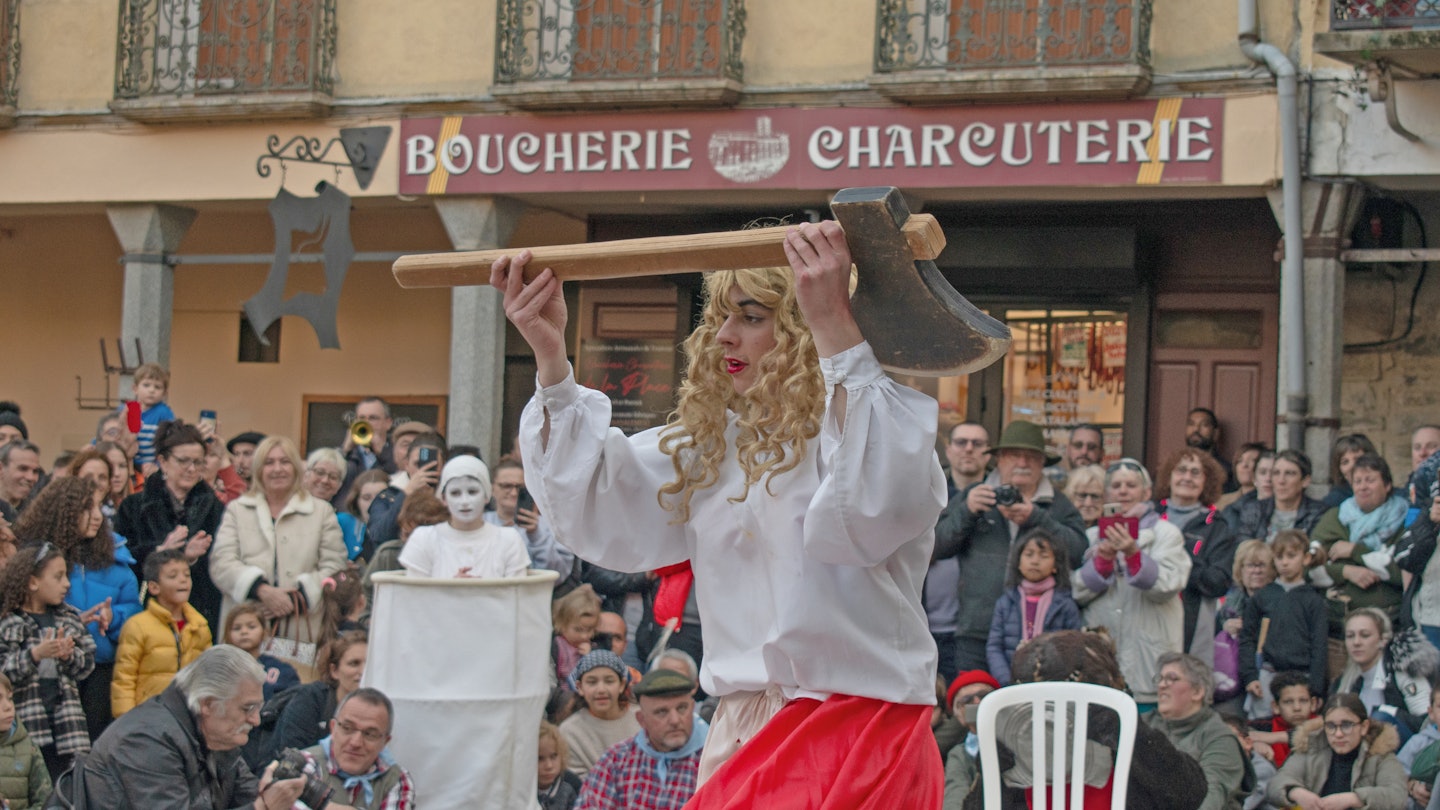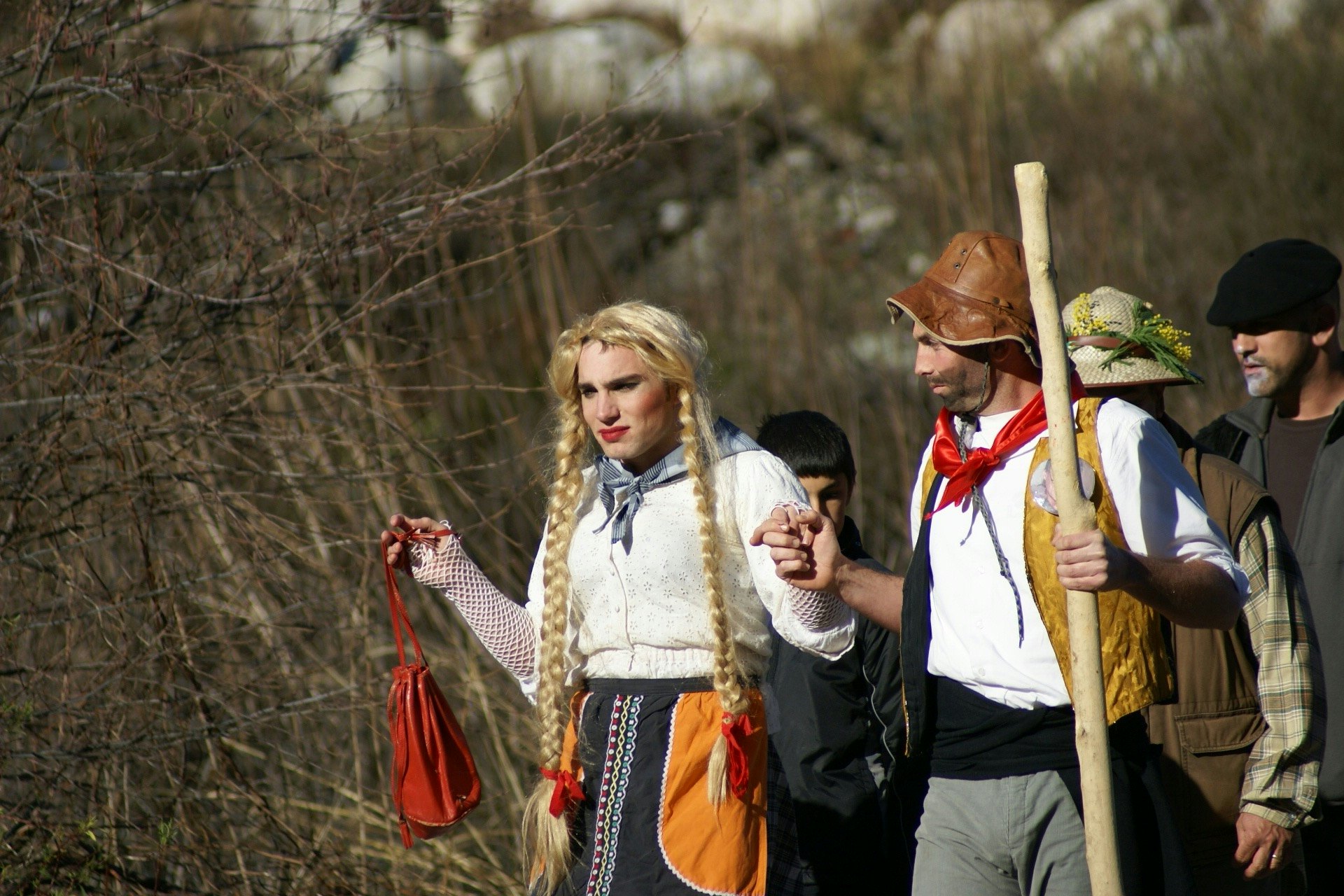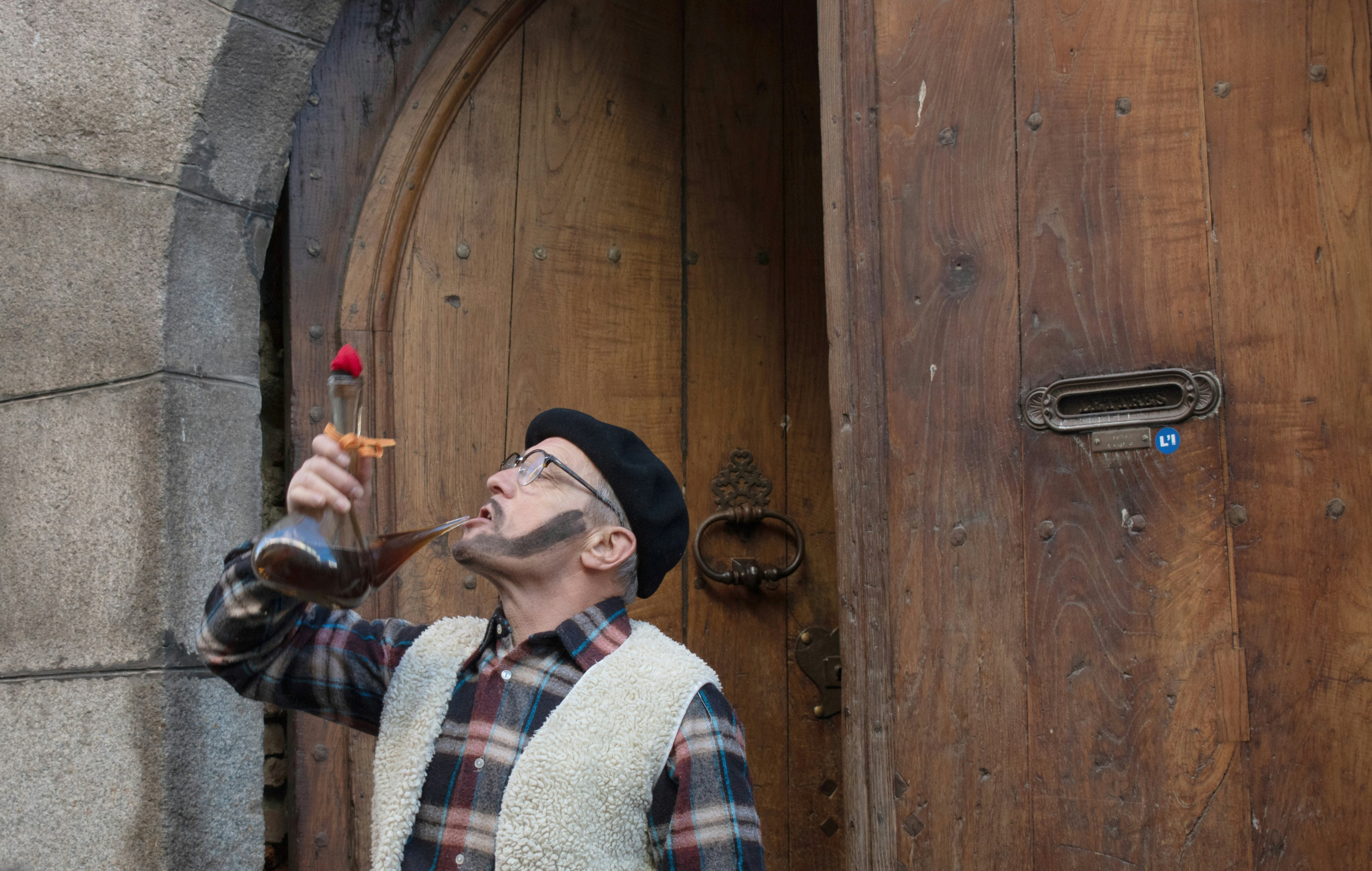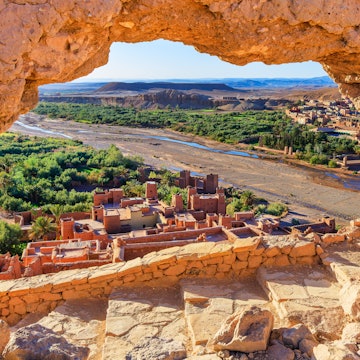
Why the Unesco-listed “Bear Festival” in French Catalonia is worth traveling for

Feb 15, 2023 • 6 min read

'Roseta' greets the crowd during the Fêtes de l’Ours in Saint-Laurent-de-Cerdans © Anna Richards
One legend, three interpretations and a very thirsty bear: here’s how to experience traditional Catalan culture at the Fêtes de l’Ours (Bear Festivals) in the French Pyrenees, the latest addition to Unesco’s Intangible Cultural Heritage List.
With a grinning, sharklike mouth and googly eyes stuck at odd angles on the sides of its head, the bear looks like a child’s drawing of the monster under their bed. Yet the fact that it’s currently being beaten around the head using a red, quilted handbag by a teenager in drag dispels any hint of scariness.
The mountain town of Arles-sur-Tech is under 25 miles (40km) from the Spanish border. Visitors from Spain feel it looks distinctly French (blue shutters, terracotta-tiled roofs and wrought-iron balconies), while those descending from the north, myself included, comment on how Spanish it feels: mosaics, colorful tiles and caves that serve pitchers of sangria. But this is French Catalonia, and Arles-sur-Tech is the first of three towns to host the Fêtes de l’Ours. With the symbolic passing of a real bear’s paw, the tradition will now move on to the town of Prats-de-Mollo-la-Preste, where another celebration will take place two weeks later.

The band is playing a combination of musical instruments I recognize (tubas, trumpets and trombones) and Catalan instruments I’ve never seen before: flabiols (a sort of recorder with a tambourine attached), tibles (not dissimilar to clarinets and a contrabaix (a kind of double bass with three strings). For at least the dozenth time, they’ve struck up the refrain from “The Bear Song,” adapted from “La Chanson de l’Ours” by Charles Trenet. (One of the most famous French singer-songwriters of the 20th century, Trenet regularly took holidays in Arles-sur-Tech.)
The bear is now causing havoc. It barrels into children wearing gaudily painted buckets on their heads, knocking them flat, then snarls at the crowd and pushes over “turtles” – children with faces painted white and Scrooge-style nightcaps hiding in collapsible canvas tubes. It even escapes across the river, only to be brought back by the “Canadian” hunter who, in vigatines (espadrilles) and a wide-brimmed black fedora, couldn’t look more Catalan.

What is it?
A folkloric festival centering around the legend of Jean l’Ours (John the Bear). There are many versions in French and Spanish mythology, most involving a creature that is half-bear, half-human. In the story commemorated during the Fêtes de l’Ours, the bear abducts local women; desperate, the townsfolk recruit the help of a hunter. The hunter’s lover, a local girl called Roseta, is seduced by the bear – and Roseta and the hunter then use an axe to shave the beast to help it regain its humanity. At the festival, this metamorphosis is symbolized by removing the bear’s head to reveal the actor underneath.
The festival is the latest addition to Unesco’s Intangible Cultural Heritage List, inscribed in 2022, to promote knowledge and understanding of traditional Catalan culture.
When is it happening?
Annually each February. Arles-sur-Tech hosts the first festival on the first weekend in February, and Prats-de-Mollo-la-Preste follows two weeks later (Sunday, February 19 in 2023). Saint-Laurent-de-Cerdans closes the celebrations on the final Sunday of the month, which this year falls on February 26.

What happens?
Fancy dress, dancing and a whole lot of theatrics. Each town has a different way of telling the story, and locals turn out in droves for all three celebrations, which last a full weekend. Saturdays are for the kids, while Sundays are the adults’ time to play. Arles-sur-Tech’s bear is a clownish, medieval-style bear with a toothy shark’s grin. Prats-de-Mollo-la-Preste has three bears, each obliged to coat themselves in a mixture of oil and soot and make their own outfits using a sheep’s skin. (In 2022, for the first time, one of the bears was female.) The bear in Saint-Laurent-de-Cerdans wears a real bearskin – recycled each year until it wears out.
In Arles-sur-Tech, both days begin with a procession through town, guided by the hunter and Roseta, to gather the townsfolk; the bear appears for the bear hunt in the afternoon. With multiple stops to refill porrós (a Catalan drinking vessel shaped like a bong) with muscat wine, the bear gets rowdier on the adults’ day. Parades are interspersed with renditions of la sardana, a Catalan dance banned under Franco, and “L’estaca,” an anti-Francoist song of resistance.

Where is it and how do I get there?
In the French Pyrenees, between Perpignan and the Spanish border. Perpignan has a high-speed train link with Paris (five hours) and direct flights to several British airports, including London Stansted and Birmingham. There are buses between Perpignan and Arles-sur-Tech (€1 flat fare). For Prats-de-Mollo-la-Preste and Saint-Laurent-de-Cerdans, change in Arles-sur-Tech. Visitors coming from North America may find it easier to fly to Barcelona and rent a car for the 118-mile (190km) drive.
Do I need tickets?
No. The festival is completely free.
Can I find food and drink at the festival?
Drinks abound during the festival. Cheap wine, beer and Ricard are on sale from the town’s two bars (Central and Can Poch). Food is more limited as locals shut up shop to enjoy the festival; expect little more than a few bakeries to stay open. Tickets for the repas des chasseurs (hunters’ lunch, Sunday from midday) can be bought by contacting the town council in advance. Vegetarians, beware: offerings are meat-heavy. Even coca catalana, a flat, sugary cake and regional speciality, usually contains either pork or duck.
Don’t forget to pack…
A camera. Preferably with a sturdy, waterproof case, especially if celebrating in Prats-de-Mollo-la-Preste, to avoid coating the lens with a potion of oil and soot.
Where should I stay?
All three towns are small and accommodation is limited: book early to avoid disappointment. The closest hotel to Arles-sur-Tech is Appart’Hôtel Castel-Emeraude in Amélie-les-Bains, half an hour away on foot. A turreted oddity decorated in lurid colors, it’s clean, has a slap-up breakfast buffet and self-catering facilities in the rooms. Hôtel le Bellevue at Prats-de-Mollo-la-Preste has, as the name suggests, a fabulous view, and hotel-spa Le Domaine de Falgos in Saint-Laurent-de-Cerdans is distinctly luxurious. Nearby Ceret and Perpignan have multiple hotels if these options are fully booked.

My picks for a perfect weekend in Arles-sur-Tech
Move over, New Zealand: this is surely the land of Tolkien novels, and the best thing to do is to go hiking in the mountains. Visible from Arles-sur-Tech and rising to an altitude of 9137ft (2785m) is Mt Canigou, which legends say is home to a dragon guarding an underground lake (Smaug?...). The summit is around 18 miles (30km) from town as the crow flies, but it takes 90 minutes by car to reach the highest parking lot in Casteil. From here, a short walk takes you to Abbey Saint-Martin-du-Canigou, with spectacular views over the mountains. Factor in a full day if summiting the Canigou.
In the town of Arles-sur-Tech itself is the 8th-century Abbaye Ste-Marie, which is well worth a visit (open Tuesday–Sunday; €4). Combine this with a visit to the old Catalan fabric factory on the fringes of the town: Le Moulin des Arts et l’Artisanat has been converted into a series of galleries and artists’ workshops showcasing everything from traditional weaving machines to stained glass.















